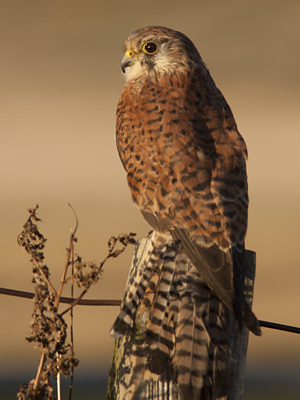Kestrel

For most of the 20th century the common kestrel enjoyed the status of being the commonest bird of prey in Scotland. A bird of the open countryside, its characteristic hovering and perch hunting techniques make it a highly visible raptor, while its habit of nesting in unusual urban locations has given it a high media profile. Although there has been no national survey, the current estimate of the Scottish population is 7,765 pairs, 21% of the UK population (36,800). The recent phenomenal buzzard recovery and the stabilisation of the sparrowhawk have relegated the common kestrel to third spot in terms of number of breeding pairs in Scotland.
The common kestrel is currently classed as being in decline. Breeding Bird Survey figures from the BTO show a serious 67% reduction of the species in Scotland. Numbers have fallen probably due to a combination of a reduction in suitable habitat for small mammals, its main prey item, and increased competition from other raptors as they have recovered from low population levels in the second half of the 20th century; the latter being a natural readjustment following historical persecution and organochlorine pesticide poisoning.
In addition, evidence is growing that Scottish vole numbers are decreasing in line with those in the rest of Europe, showing cyclic peaks lower than in previous decades. There is also a discernable increase in the levels of second generation anticoagulant rodenticides being found in common kestrels, and the recent trend of wetter springs could have affected the foraging ability of kestrels and a reduction of clutch sizes related to rainfall figures has been recorded. The probability is that the common kestrel’s decline is due to a number of factors rather than one specific cause.

Although very catholic in its prey range, the short-tailed field vole is the preferred prey and in upland grassland both territory occupation and breeding performance are closely tied in to the three year cycles of this small mammal. In peak vole years, common kestrel territory occupation is high, clutch sizes large and brood survival high. When the vole numbers bottom out after the peak the kestrel’s occupancy and productivity levels also fall.
The common kestrel’s breeding strategy is based upon a quick turnover of the population, compensating for a high mortality rate (up to 60% of juveniles die in their first winter) with clutch sizes of 4 to 6 and good brood survival. They are partial migrants, young birds from Scotland moving south after dispersal from family groups to winter in southern England and northern Europe. The common kestrel is not in danger as a species but the situation does need to be carefully monitored and conservation action taken if the decline continues at the same pace. In its favour the kestrel’s lifestyle – mobile, able to feed on a range of prey, takes readily to nest boxes and a variety of sites and a high productivity rate – means it has the potential to bounce back quickly from adversity.
Gordon Riddle
References:
Riddle, G. (1992). Seasons with the Kestrel. Blandford Press, London.
Riddle, G. (2011). Kestrels for Company. Whittles Publishing, Sutherland.
Shrubb, M. (1993). The Kestrel. Hamlyn Species Guides, London.
Village, A.. (1990). The Kestrel. T&AD Poyser, London.
Website: www.riddle-kestrel.com
Scottish Raptors• Honey-Buzzard• Red Kite• White-Tailed Eagle• Marsh Harrier
Hen Harrier• Goshawk• Sparrowhawk• Common Buzzard• Golden Eagle
Osprey• Kestrel• Merlin• Hobby• Peregrine Falcon• Barn Owl
Tawny Owl• Long-eared Owl• Short-eared Owl• Raven
